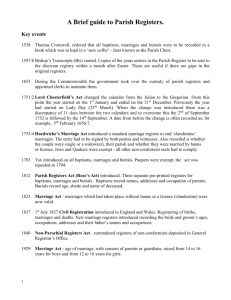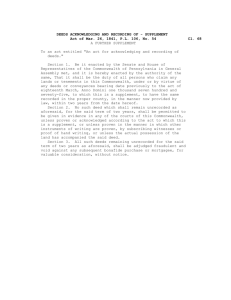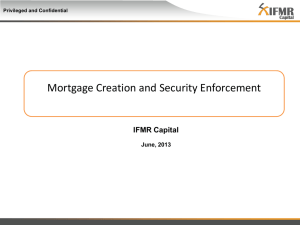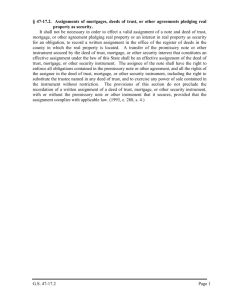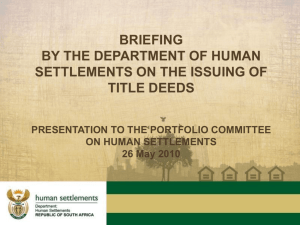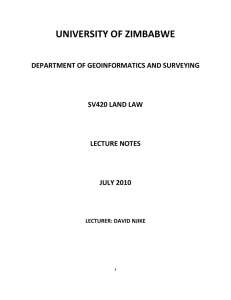A Brief Guide to Title Deeds
advertisement
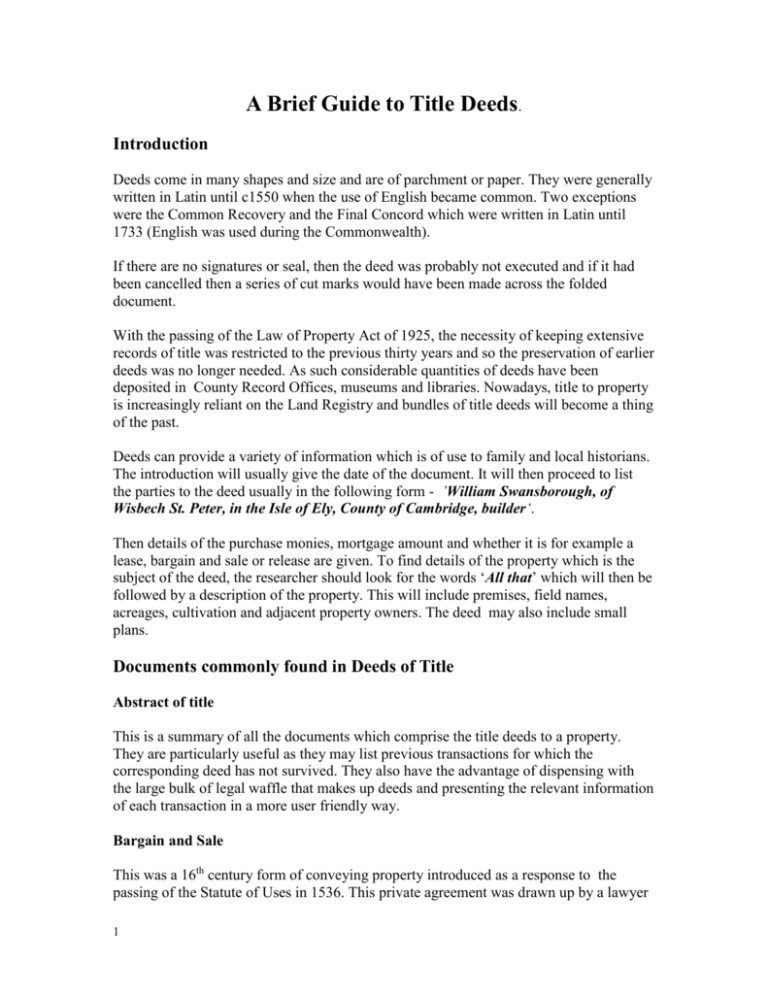
A Brief Guide to Title Deeds. Introduction Deeds come in many shapes and size and are of parchment or paper. They were generally written in Latin until c1550 when the use of English became common. Two exceptions were the Common Recovery and the Final Concord which were written in Latin until 1733 (English was used during the Commonwealth). If there are no signatures or seal, then the deed was probably not executed and if it had been cancelled then a series of cut marks would have been made across the folded document. With the passing of the Law of Property Act of 1925, the necessity of keeping extensive records of title was restricted to the previous thirty years and so the preservation of earlier deeds was no longer needed. As such considerable quantities of deeds have been deposited in County Record Offices, museums and libraries. Nowadays, title to property is increasingly reliant on the Land Registry and bundles of title deeds will become a thing of the past. Deeds can provide a variety of information which is of use to family and local historians. The introduction will usually give the date of the document. It will then proceed to list the parties to the deed usually in the following form - ’William Swansborough, of Wisbech St. Peter, in the Isle of Ely, County of Cambridge, builder‘. Then details of the purchase monies, mortgage amount and whether it is for example a lease, bargain and sale or release are given. To find details of the property which is the subject of the deed, the researcher should look for the words ‘All that’ which will then be followed by a description of the property. This will include premises, field names, acreages, cultivation and adjacent property owners. The deed may also include small plans. Documents commonly found in Deeds of Title Abstract of title This is a summary of all the documents which comprise the title deeds to a property. They are particularly useful as they may list previous transactions for which the corresponding deed has not survived. They also have the advantage of dispensing with the large bulk of legal waffle that makes up deeds and presenting the relevant information of each transaction in a more user friendly way. Bargain and Sale This was a 16th century form of conveying property introduced as a response to the passing of the Statute of Uses in 1536. This private agreement was drawn up by a lawyer 1 and had to enrolled in a court within six months and accordingly many of these documents bear a record of the enrollment in an official hand. This method of conveyancing was gradually replaced by the lease & release. Bond A bond deed is an agreement to perform certain duties with a penalty for nonperformance. It is in two parts: the top is obligation gives the penalty (this part was in Latin until 1733). The bottom part is the condition, which was written in English, and states the commitment to be performed i.e. to produce title deeds. Common Recovery This was a fictitious legal action in which the purchaser, recoverer, sued the vendor, tenant, alleging that he had no legal title and possessed the property only a after fictitious third party had forced the recoverer out. The actions were held in the Court of Common Pleas and date from the 15th century to 1833. These actions were often preceded by a deed to Lead the Uses of a Recovery. Feoffment The oldest form of conveyance by a symbolic handover known as a livery of seisin - the physical occupation of a property in front of witnesses. The document confirming this needed to be endorsed to record the entry into the property or else it was not valid. Feoffments were later replaced by Bargain and Sales. Final Concord (fine) A final agreement to settle a fictitious court case in the Court of Common Pleas, whose real aim was to transfer property. The case was brought by the purchaser, plaintiff, against the vendor, deforciant, alleging that he had been deprived of the property in question. Before a judgement was made the two parties reached a compromise - the purchaser received the property and the vendor a sum of money which was the purchase price. The deed was an indenture tripartite and consisted of three copies of the fine on a single sheet. The copies were separated by wavy (indented) cuts and a copy was given to each party and the third copy at the bottom was kept by the Court - these are known as foot of fine. These actions were preceded by a deed to Levy a Fine. Indenture A common name for a deed which is so called because of its physical appearance. Two copies of the deed were produced from one sheet. They were then separated by wavy (indented) cuts and a copy was given to each party. Lease & Release 2 The lease & release was a popular form of conveying property without the need of enrolling a deed and was used up to 1845. In the first part, the lease, the purchaser leased the property for one year and thereby avoided the need to enrol the deed as they already occupied the property. The following day the vendor released the reversion of the lease to the purchaser and the transfer was complete. The smaller lease is often found tucked inside the larger release. Will/probate/administrations Copies of wills and probates are often found within sets of title deeds. Where a person has died without making a will (intestate) then there may be a grant of Letters of Administration. Wills vary in size from single sheets to several pages. Manorial deeds/ transactions and terms Acknowledgement of Satisfaction The was usually a declaration that a mortgage had been satisfactorily repaid and thus extinguished a conditional surrender. Admission When a person bought or inherited land or premises they would pay homage to the Lord (or his Steward) and would then be admitted as the tenant of the property. This transaction was known as an Admission. Conditional surrender This was the practice of mortgaging copyhold land. If the loan were not repaid the mortgagee could only take possession of the property if the Lord of the Manor accepted them as tenant. Copyhold A form of land tenure deriving its name from the practice of giving the tenant a copy of the entry in the rolls (later books) of court baron of the manor which record their possession of property. The tenant paid homage to the lord and was granted land in return for services to the lord. This was converted into a money payments involving large entry fees and small annual rents. This form of land tenure was abolished in 1922. Court Baron 3 A manorial court which dealt with, among other things, the transfer of copyhold land. Usually held every three weeks. Enfranchisement The process of converting copyhold land to freehold land. The process began in the 1880s and became universal in the 1920s after the extinguishment of manorial incidents. Presentment This was generally a statement made at a court baron. The declaration of the death of a tenant of the manor was an opportunity for the deceased’s heirs to come forward to claim their copyhold premises and land held of the manor. Three such presentments were made and if no one claimed the property then it would revert to the Lord who would grant it to new tenants. Surrender (also absolute surrender) A document which ends a owner’s right to a property. The property would be surrendered into ‘the hands of the Lord of the Manor’ (or his Steward) . The new occupier would then pay homage to the Lord and would then be admitted as the tenant of the property. Surrender to the uses of your will Usually undertaken by a tenant after their admission to property. After their death the copyhold land and premises would be transferred as directed in the tenant’s will. 4
